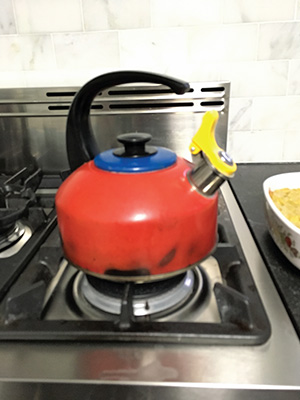
Pesach is coming. It’s time to prepare the kitchen and clean all the pullets to get them ready to make plentiful pots of chicken soup. Out comes the well-worn, inexpensive red tea kettle with the blue cap and yellow spout, the primary colors that matched our kitchen wall covering 29 years ago when our first child was a newborn. I can’t help keeping the old relic. With the children out on their own and living in all parts of the country, it beckons them as they return for the Seders. It’s the first thing they look for even before asking, “What’s to eat?”
This year is extra-special because our son is engaged. I knew that his fiancée was a keeper from the first time she came for Pesach and he pointed out the tea kettle with the red paint half burnt off the sides, and she reacted, “How cute.” My husband knew she was the one when she unabashedly led Dayenu.
In just a few days, we will sit at the Seder table, open our Haggadahs and hear the story of the Exodus. During the Seder, we will happily reminisce about all things “Pesach” from our own family tradition. The table at our house will be set with Papa Harry’s sugar bowl. He was the patriarch of my mother’s family. A religious man, he davened twice a day, in between ice and coal deliveries in Roselle and Linden and, according to my mother, he made the best gefilte fish. You could hear her lips smacking when she spoke about the delicacy.
There are all other kinds of precious hand-me-downs from our ancestors’ pasts, including items gifted to us at our engagement and wedding. With an inventory in my head, I can name the relatives who were the presenters and for which occasion. Now that various cousins come to celebrate with us, we get to talk about all those who came before, regaling our three children with not just the history and meaning of the items on the Seder plate, but with legends of our own family and their meaning to us.
Our childrens’ eyes quickly gaze at the “art” from their preschool years, Hebrew school lower grades and religious summer camp days, which take care of the matzah cover, afikomen bag and other extras. From reading this, teachers and counselors should know that their projects were well worth the effort, a full two decades plus later, as they surely grace more Seder tables than ours alone.
Maybe it’s the time spent on the preparation, changing the dishes and all the cooking and baking, but all kinds of things from Passovers past jump through my mind. One much older cousin gifted me a hand mixer in green before my 1975 wedding, and since I wanted a red kitchen, I saved that tool for Pesach. Now her daughter and grown grandchildren celebrate the holiday with us. I think of that blender (with which I made Aunt Fannie’s tried-and-true recipe for sponge cake for more than 30 years before it gave out and I bought a newfangled one), and the cousin who gave it to us, when I prepare my cake batters.
As the memories flood over me, and one leads to another, I think of a classic family Pesach story. Our daughter was born Erev Pesach in 1990, and my mother’s response to me going into labor is forever planted in my mind. Summoned to come with my father to watch our 2-year-old son while I was in the hospital, she cried. They were not the tears of joy that one would expect, but rather tears of, “How will I ever get ready for Pesach?”
One story begets another and this takes me back a generation and reminds me of my own childhood Passovers. My mother would scour the bathtub in our Roselle apartment and, with the tub cleaned to perfection, she would then call me in to help her wash all the pots my father and three older brothers had lugged up to the second floor from the cellar in the four-family house. Generations of pots used only eight days a year were stored in old wooden pickle barrels, reminiscent of a scene straight out of a Woody Allen movie.
From clean pots, my thoughts naturally return to food. My mouth begins to water thinking of the meat knishes my mother would make for the holiday. For some reason, that’s one important family recipe I don’t have on record with all the others and, oh, how I miss it.
I know that, as you read this, you are thinking about your own Passovers and Seders past. Save all the reminiscing for your Seder table. For now, as my dear mother would have said, “Hak mir nisht keyn tshaynik,” the weakened whistle is blowing; it’s time to clean all those chickens.
By Sharon Mark Cohen











